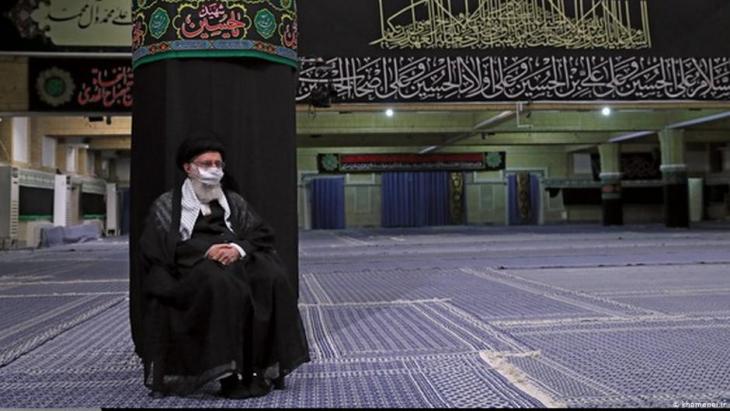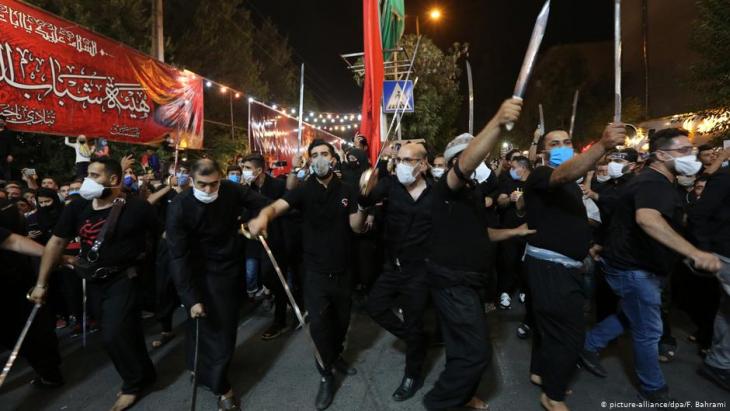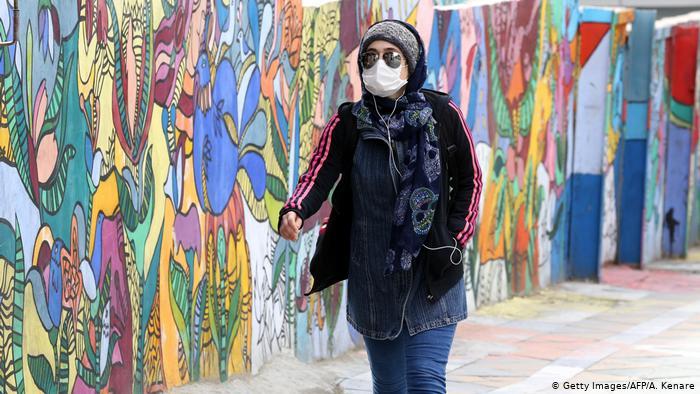Power, identity and the coronavirus

The power wielded by this invisible enemy is immeasurable. The coronavirus is not only attacking this world but also obliterating many of the customs designed to manifest the hereafter: religious processions, for example.
For the Islamic Republic, the danger emanating from this foe is growing because in Iran, worldly and divine power are one and the same. The most powerful man in the country calls himself Ayatollah, the sign of God. Before the coronavirus pandemic, he demonstrated this dual power with religious mass events, processions held on various occasions in which millions of people took part.
These events even spread across borders, for example the commemoration of Hussein, the third imam of the Shias, on the 40th day after his death (Arbaeen), for which every year hundreds of thousands of pilgrims cross the Iran-Iraq border on foot to visit Hussein's shrine in the city of Karbala.
The kilometres-long processions following this Shia Way of St James always provided impressive images for the centre of dual power in Tehran – images that were meant to intimidate every enemy, near and far. But those days are over. COVID-19 is an enemy of God, say Iranian websites. With good reason too, because it is currently rendering Iran's dual power structure powerless. Just how mighty the small virus is became particularly evident during the month of Muharram, which is dedicated to Hussein, the third Imam of the Shias.
A universe called Muharram
"Everything we have we owe to Muharram; keep Muharram alive": a remarkable, enduring statement, which was meant to herald a mission for all eternity. It was spoken by Ayatollah Ruhollah Khomeini after the victory of the Islamic revolution in Iran 40 years ago.

Muharram is the first month of the Islamic calendar. On the tenth day of this month, known as Ashura, Hussein, the third Shia imam, was killed at the Battle of Karbala. According to the Christian calendar, this took place in the year 680, in the Islamic Hijri year 61. It falls this year on the 29th of August.
Behind these dates is a complex universe which myriad sociologists of religion, mythologists, ethnologists, historians, psychologists and political scientists still struggle to make sense of. What really happened on Ashura? What is the significance of this event for the history of Shiism? What ideas does Ashura convey and why are its myths and rites still so powerful and omnipresent? How decisive was Ashura for the victory of the Islamic revolution in Iran? How do the current rulers of the Islamic Republic treat this day?
The list of questions is as open-ended as the search for answers. Libraries could be filled with what has been written since the seventh century about this day, its background and its consequences.
The month of identity
In Shia popular belief, Imam Hussein is known as سید الشهدا – "Lord of the Martyrs". He is, in many respects, even more important than Jesus is to Christians. Like Jesus, Hussein also stands for justice, and he, too, fell victim to enemies who murdered him without mercy. By contrast, however, Hussein was a warrior, a brave and resolute fighter who rose up against an unjust ruler, knowing that he and his comrades-in-arms would be killed and his family taken prisoner. For centuries, Hussein's final days have been commemorated on the first ten days of the month of Muharram with weeping and lamentation in street processions that often feature a lot of blood. This is an unparalleled annual mass event that has turned into a veritable industry.

Over the course of time, this cultivation of a martial tradition has shaped Shia identity. Hussein gradually mutated into a revolutionary, a hero that everyone must emulate. Knowing this background is the key to understanding why Khomeini said that he owed everything to Muharram. He was telling the truth. With this sentence, Khomeini summarised his own life experience.
A month of revolution
In 1963, Ashura fell on 3 June. There were street processions all over Iran. In the afternoon, a little-known cleric stepped up to the pulpit at Qom Seminary and gave an incendiary speech about the never-ending revolutionary mission of Imam Hussein.
In his sermon, the cleric did something outrageous: he personally attacked the Shah, condemning his White Revolution and urging him to repent and return to Islam. This was Khomeini's first step onto the political stage – both in Iran and beyond. Two days later, he was arrested. He subsequently went into exile.
During the years of Khomeini's exile, Ashura became an occasion to remember not only Hussein's rebellion against the powers that be, but also the exiled Khomeini. Fifteen years later, at the start of the Iranian Revolution in 1978, Ashura became a political demonstration with millions of participants and Khomeini's image displayed everywhere. The rest, as they say, is history.
Khamenei's "Camino de Santiago"
Khomeini's successor, Ali Khamenei, went even further and tried to give the annual street processions a new, cross-border dimension. On Hussein's day of remembrance, Shias from all over the world should go on pilgrimage to Karbala in Iraq, on foot, of course, and preferably barefoot. Khamenei thus inaugurated a sort of Shia Way of St James.
[embed:render:embedded:node:26690]In recent years, his initiative has given rise to archaic and exhilarating scenes. Thousands of Shias from Afghanistan, Pakistan and other countries would first gather in Iran and then, together with hundreds of thousands of Iranians, walk across the border towards Karbala to visit Imam Hussein's shrine. Likenesses of Khamenei lined the path like milestones. Water and rations were distributed to the pilgrims all along the one-hundred-kilometre route. This demonstration of both political and religious power was designed to impress the whole world, especially the Sunnis.
And it became a religious showdown between Tehran and Riyadh. While the Saudi rulers put themselves in the limelight every year when millions of pilgrims head to Mecca for the Hajj, Khamenei countered with his million Shia pilgrims making their way to Karbala on foot.
Khamenei disappears from the public spotlight
But all this now seems like a story from the old days, the pre-COVID-19 era. This year, the virus forced the Saudis to ban pilgrims from Mecca and to limit the Hajj to about 1,000 people from their own country. And in Iran?
The processions planned from the first to the tenth day of the month of Muharram were to be relocated to the virtual world and to take place mainly on television. But not every believer was prepared to accept this. Despite urgent warnings, hundreds gathered every evening in some Iranian mosques, weeping and mourning to commemorate Hussein. The result: the number of "red zones" with increasing numbers of coronavirus infections has been rising continuously since then. It is therefore doubtful whether schools will reopen for the coming school year.
Khamenei himself has been avoiding the public eye for the past six months, appearing only now and then on television. This means he has to forgo the erstwhile showy displays of his dual power. And the procession of millions of pilgrims to commemorate the 40th day after Hussein's death will not take place this year either. The government in Baghdad has announced that the border with Iran will remain closed.
Ali Sadrzadeh
© Iran Journal 2020
Translated from the German by Jennifer Taylor